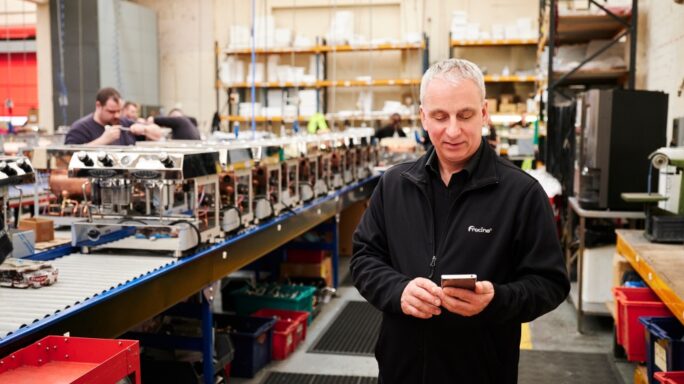People & Leadership
How to tackle the manufacturing skills shortage
Learn how your firm can tackle the manufacturing skills shortage and attract top talent, while retaining your staff by supporting them in their careers.

UK manufacturers are facing the biggest shortage of employees for 30 years, according to the British Chambers of Commerce. So how can your manufacturing firm address the skills shortage and improve the prospects for your business?
Read this article to find out how you can buck the trend with advice to help you recruit and retain the best talent for your manufacturing business.
Manufacturing skills challenge
In total, 81% of manufacturers and 70% of service firms said they were struggling to find suitably skilled staff, according to a survey of 6,000 manufacturers, carried out by the British Chambers of Commerce in 2018.
The biggest age group working in manufacturing is those aged over 40, according to the Chartered Institute of Personnel and Development (CIPD), with many of those employees much older and approaching retirement.
These staff often have decades’ worth of experience and specialist skills at risk of being lost forever when they stop working.
Talent pipeline issues
Meanwhile, the manufacturing industry is still struggling to attract a pipeline of young talent to fill roles when older people retire.
That’s a big problem, because millennials – those people born between 1980 and 2000 – will make up 75% of the global workforce by 2025, according to a 2014 Deloitte study.
It’s also a wasted opportunity. Generally, younger people are well skilled in terms of modern technology usage and are well-placed to champion emerging technologies such as artificial intelligence (AI), augmented reality, robotics and the Internet of Things, which are key in a global shift towards digitisation.
Manufacturing careers shouldn’t be seen as boring – so the industry clearly has an image problem.
A poll found that less than 20% of parents would encourage their children to work in manufacturing, believing the sector to be dirty, monotonous, low skilled and poorly paid.
These are myths we need to bust. Particularly as the average weekly wage of £600 in manufacturing is higher than the UK average of £516 per week, according to the Office for National Statistics.
So, what can manufacturers do?
How one manufacturing firm is tackling the skills shortage
One company that has successfully introduced a programme to upskill and develop staff is PP Control & Automation, which has 220 employees and annual sales of £25.3m.
The firm offers outsourced manufacturing services to clients in a range of sectors, including aerospace, food processing, machine tools, medical, packaging, printing and advanced technologies.
Operating in multiple sectors and countries, the firm has diverse training needs. Recognising that people are its best asset, it implemented a programme to upskill staff and maximise the potential of the business.
In 2000, the company also set up an internal training school offering a range of best practice workshops to staff.
Every member of the 220-strong workforce has a personal development plan that identifies the skills and training individuals need to grow and positively influence the company. Examples include lean manufacturing courses or professional qualifications.
The business has also invested in 27 apprenticeships. As well as those starting their careers, the roles are also extended as an add-on to existing production and logistics managers looking to learn new skills and become more agile in meeting customer requirements.
Tony Hague, CEO of PP Control & Automation, says: “A colleague once asked why we invest so much in our people, when they could just up and leave the next day. My response was simple – imagine if we didn’t invest and they stayed.
“Training has to be at the heart of any business, but it can’t be prescriptive.
“You have to understand the skills the company needs and the best way of getting them, while giving your staff the chance to meet their own personal aspirations.
“It’s a delicate, but ultimately, rewarding balancing act.”
Challenges of adopting tech that employees aren’t familiar with
Very few people would argue with the principle of providing more training.
But in reality, highlighting gaps in the knowledge of your employees, and areas for improvement, is a potentially sensitive area that can leave some people feeling like they’re out of their comfort zones.
According to a report by the CIPD, older employees are more than twice as likely to have received no training, compared with their younger counterparts.
In total, 27% of those aged 45 years and over received no training, compared to just 13% of 18 to 24-year-olds.
Any strategic shift towards new things can be unsettling for any employees. But by offering the right support and providing the tools to help your workforce develop their skills, while also showing them the benefits of change, you’ll breed confidence throughout your firm.
How to support your employees
As a first step, it’s vital that you clearly communicate the purpose of any changes and how they will benefit the employees involved.
You’ll need to reassure people that the changes will allow them to focus on value-add activities, such as the repair and maintenance of equipment, data analysis, and working on projects they really enjoy.
It would be wise to set up a project team with representation from all key areas of the business. You’ll need to adopt a methodical approach to gathering business requirements, and mapping your existing processes to identify gaps and areas for improvement.
After carrying out a thorough review, you’ll be able to identify gaps within your skills base.
You may need to provide practical training in areas that are uncharted for your business, such as automation, AI, Internet of Things, data analytics, augmented reality and virtual reality.
It’s worth implementing individual and company-wide training plans to ensure continuous learning underpins your business in the long term, which will help to ensure the transition is not viewed by staff as a tick box exercise.
Solutions for tackling the skills shortage
Here are six things that manufacturers, and the industry at large, can do to reverse the skills shortage.
1. Look at the big picture
Tackling a skills shortage at industry level is one area where two heads are better than one.
To make a real difference, solutions for tackling the skills shortage should involve collaboration between government, industry, manufacturers, and young and older employees.
Try joining forces with specialist organisations such as In-Comm Training. The company works with hundreds of engineering firms and manufacturers to gather business and industry requirements to inform training programmes and ensure content meets the needs of employers.
It’s also worth working alongside other manufacturers, training organisations, networking groups, and industry associations such as Make UK, which offer ongoing advice and campaign on tackling the skills shortage.
2. Retain your older employees
While there is a shift towards technology, it’s important not to lose the skills of your older employees.
Bekki Phillips, managing director of In-Comm Training, says: “We believe in new technology but it’s equally important to develop fundamental and practical hand skills.
“Otherwise what do you do if a machine breaks down and you need to get an order out?”
Another firm that can help with capturing employees’ existing skills is PTC. It provides technology that lets skilled manufacturers record a task as they carry it out, using a wearable device such as Microsoft’s HoloLens.
The content is then turned into a step-by-step video guide with instructions for other employees to follow through the wearable tech, locking valuable skills in place forever.
It’s also worth considering succession plans for older employees.
The smartest companies are offering retirement plans and recognising that flexible working is just as big a draw for the older workforce as the young. They’re also finding alternative roles for older employees, such as teaching.
Phillips adds: “We can train people to be tutors but we can’t teach experience. For those approaching retiring, it’s important we pass on their skills to the next generation.”
3. Get ‘hands on’ with training
Many manufacturers prefer practical rather than academic training.
Employees have the opportunity to ‘try before they buy’ on equipment worth hundreds of thousands of pounds – free of financial risk, at specialist training centres.
In-Comm Training has invested £7m into three Technical Academies – at Aldridge, and its Marches Centre of Manufacturing & Technology (MCMT) hubs in Bridgnorth and Shrewsbury.
These centres accommodate a wide range of hi-tech machinery and technologies for functions such as CNC (computer numerical control), metrology, robotics, wire EDM (electrical discharge machining) and fluid power.
The three sites also attract more than 800 apprentices every year, who work on 40 trailblazer standards, including mechatronics and welding, to machinists and heritage engineering. They have been tempted by the prospect of getting to grips with state-of-the-art kit as well as textbooks.
4. Work in partnerships
Consider working alongside your local further and higher education centres, which have immediate access to a pool of talented and enthusiastic young people.
In-Comm Training has built a partnership with the University of Wolverhampton to offer an HNC Higher Apprenticeship in Engineering.
This enables students to gain an apprenticeship, as well as Level 2 and 3 qualifications towards a degree – while avoiding the massive debt normally associated with pursuing this route at university.
This addresses the needs of young people, as well as the manufacturing industry.
5. Recognise that it’s never too early to build interest in manufacturing
While it won’t immediately improve your bottom line, there is a moral case for manufacturers working to inspire future generations into manufacturing.
Staff from In-Comm go into schools and speak to children from the age of seven to pique their interest in manufacturing. The company also promotes manufacturing jobs and apprenticeships at careers fairs.
Perhaps your business could think about getting involved with programmes such as Go4SET, which provides work-related learning within an industry or enterprise context.
Or you could consider opening the doors of your manufacturing firm to young people, following in the footsteps of Nissan and Bombardier.
6. Listen to the needs of young people
Companies such as Google and Apple haven’t simply been lucky in attracting talented young people. They’ve offered flexible and remote working, unlimited holiday time and tools to encourage creativity in order to appeal to prospective employees.
These forward-thinking firms recognise that factors other than pay – dubbed intrinsic motivators – are big drivers for young people.
Follow in their footsteps and your business could take the steps in the right direction to get new talent (while holding on to existing employees) through your doors.
Discrete manufacturing in a changing world
Discover how economic, environmental and regulatory changes are changing the face of manufacturing, and learn about strategies that can help your firm remain productive.







Ask the author a question or share your advice